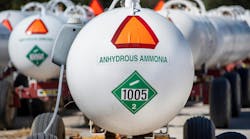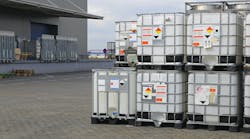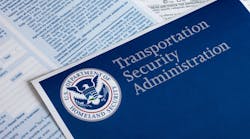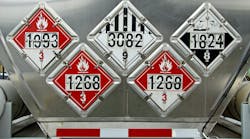SUZANNE Rach and David Ford of the Federal Motor Carrier Safety Administration (FMCSA) made a presentation during the 2017 Tank Truck Week that was designed to answer what they say is the most-asked question: Can you do an Environmental Protection Agency (EPA) Method 27 Test in lieu of a leakage test?
They faced some pushback from attendees who either didn’t understand it or didn’t agree with it.
Rach and Ford started by presenting a video to explain the Method 27 Test, which is designed to determine the vapor tightness of cargo tank motor vehicles (CTMVs) designed to haul gasoline and other petroleum-based products.
Three parts make up the test: an internal pressure test; internal vapor valve test; and internal vacuum test.
The pressure and vacuum test are similar in nature. Both require two consecutive runs, with final readings being within one-half inch water pressure of each other. The internal vapor valve test is performed one time.
The most common measurement device is a water manometer, which is a U-shaped tube half-filled with water.
From the video:
“For a tank to pass the Method 27 internal pressure test, it must make two consecutive runs that are within one-half inch water pressure. The average of two tests must meet the criteria for the capacity of the vessel. The average of the two pressure tests performed on a cargo tank with a capacity of 2,500 gallons or more must not exceed one inch water pressure. The internal vapor valve test is performed once and the maximum allowable increase in a tank’s manifold pressure is five inches water pressure.
“The internal vacuum test must meet the same criteria as the internal pressure test. Two consecutive runs must agree within one-half inch water pressure. The average of two consecutive test runs must comply with the allowable pressure and vacuum changes for the capacity of the tank.
“Each test is performed for a duration of five minutes. Pressure and vacuum readings are recorded at the beginning and end of the test time. Existing vapors and the internal temperature of the tank can affect the initial test pressure readings. Be sure to ask if the tank’s volatile vapors have been removed and the tank’s temperature allowed to stabilize to the testing environment. Some shops allow the trailer to sit a full hour inside the facility in order to stabilize.
“The inspector begins the procedure by attaching a static ground connection to the tank. He then verifies the tank compartments are empty by draining any remaining liquid into a metal bucket. Plastic buckets cannot be used for this test because a plastic bucket can carry static to the ground charge. Once the inspector has drained all compartment valves, he opens all internal valves between compartments. This allows the tank to be pressurized as a single unit.
“After connecting the test equipment to the vapor recovery line, the inspector proceeds to the top of the tank to check the assemblies. Typically the inspector will check the assemblies to make sure they have a proper seal. He makes sure the pressure vacuum valves are in working order and, using a cup of dark liquid such as coffee, checks overfill probes. When the probe touches the dark liquid, the probe will register a green light on the system down below. Some facilities may use an externally connected test instrument for this check. Inspectors may begin the Method 27 Test procedure by performing a drag run pressure test. A majority of any potential leaks will be found during this phase. This allows repairs to be made and then the test can be run consecutively with success.
“The inspector should verify that his measurement device is calibrated correctly. Once this is done, he begins adding pressure to the tank slowly. The inspector puts more air pressure into the tank to allow settling to occur. Once the tank is pressurized, the inspector will let the tank settle to ensure that pressure is equalized throughout the vessel. The air pressure inside the tank must be at a minimum of 18 inches water. Once the tank is settled, the beginning test time is noted and the inspector records the initial test pressure. After five minutes, the test pressure is recorded, the tank purged of air, and the test performed a second time. The tank must successfully pass two consecutive runs of the test. If the tank fails a second test, a minimum of two more tests must be performed to meet the test standard. The facility is allowed to perform several runs of the test to meet the requirements. Some facilities may choose to perform the internal vapor value test next.
“Once the air pressure is released from the manifold, the inspector is looking for a pressure increase of no more than five inches water pressure. If the vessel passes the vapor valve test, the inspector will proceed to the vacuum test.
“To prepare for the vacuum test, the inspector must reopen the internal vapor valves and clean out the air pressure still inside the tank. The vacuum test requires the tank to be evacuated to a minimum of six inches water. The tank must settle for a few minutes in order to equalize internally. Once settled, the inspector notes the time, records the vacuum pressure, and waits for the required five minutes. At the end of the five-minute test, the inspector records the vacuum pressure readings and repeats the test. Like the pressure test, the tank must successfully pass two consecutive runs of the vacuum test with results within one-half inch water pressure. The facility can perform multiple runs of the test to meet the requirements. At the end of the second vacuum test, the inspector records the vacuum pressure. If the measurements fall within the acceptable criteria, the test is complete.”
Ford said that carriers must make sure cargo tank maintenance shops doing the Method 27 Test also check the internal valve, or those rare tanks with external valves.
“Those have to be tested for leak tightness during the leak test,” he said. “The Method 27 Test has nothing to do with the internal valve. And there are different ways of doing that, depending on what kind of tank you have, but you have to make sure the internal valves are being leak-tested as well. The standard leakage test is 80% of the MAWP—the maximum allowable working pressure of the tank.
“It’s important to understand what is being tested for with the EPA Method 27 Test. The inspector is looking at the vapor recovery system. Leaking cargo tanks are not their problem. They’re the Department of Transportation’s (DOT’s) problem. So it’s a completely different test. It was never intended to test the leak tightness of the tank. It’s intended to test the leak tightness of the vapor recovery system. So the static pressure on gasoline is at least 1½. So I’ve had a lot of shops tell me that they put their tanks through the EPA Method 27 Test. The next day, they put gasoline in it and all of sudden got leaks that the Method 27 Test didn’t find. The reason is that it’s only about a half a pound of pressure. They’re testing the vapor recovery system. They’re not worried about the integrity of the cargo tank wall.
“EPA and DOT are very different in their philosophy about regulations. DOT says hazmat regulations apply across the country, intrastate and interstate, and that their regulations are essentially supreme. You can’t have anything that’s substantially different.
“EPA takes a different philosophy. They say, ‘Well, these are our standards, but if you want to change them a bit for your state purposes, that’s fine.’ Many states have an EPA Method 27 test that is different than what’s spelled out in CFR 40. So your tester should be checking the state test during that federal test. For our purposes, for DOT purposes, you have to use the one in Part 40. If a state has a different process for Method 27, you have to do ours and EPA’s to meet the federal standard and you’ve got to do the state’s to meet theirs. That’s a common issue people are not aware of and are not doing. They just do the state test and don’t even look at EPA’s test.”
When can the Method 27 Test be done? He said it has to be for a cargo tank that transports petroleum distillate fuels and must have a vapor recovery system.
“Most people, when you say ‘petroleum distillate,’ think you’re talking about something made from crude oil,” he said. “PHMSA came out with an interpretation a year ago, and it’s important to understand that FMCSA does not write hazmat regulations. The Pipeline and Hazardous Materials Safety Administration (PHMSA) writes them for air, water, rail, and highway. We enforce them as they apply to highway transportation. PHMSA came out with an interpretation.”
For the purposes of the Method 27 Test what is a petroleum distillate fuel and what is meant by “dedicated service”?
“PHMSA said, ‘Well, this is an EPA Method 27 test. We are just adopting EPA’s test,’ ” he said. “What does EPA call a petroleum distillate fuel? EPA considers it completely different than what most people or DOT would consider petroleum distillate fuel.
“The first thing is, dedicated means if you haul one load of something that does not meet the definition of petroleum distillate fuel, you must use the standard leakage test. So EPA defines petroleum distillate fuel based on Reid vapor pressure. You’ve got to have Reid vapor pressure of 4 psi or more. It has nothing to do with whether or not it’s made from crude oil. It’s strictly on Reid vapor pressure.
“So if you Google Reid vapor pressure for various chemicals, you come up with: gasoline, we’re good, 385, we’re good; ethanol, we’re good. The big one there is diesel. Diesel is not considered a petroleum distillate fuel for the purposes of the Method 27 Test because it generally has a very low Reid vapor pressure. So if you haul one load of diesel in a year in that cargo tank, you must do the standard leakage test. You cannot use the Method 27 in lieu of DOT’s leakage test requirement.”
Ford said if you have a spec cargo tank and you haul nothing but water with it and that spec plate is visible, you are still subject to the regulation because you are representing that as a specification cargo tank.
“Whether or not it hauls hazmat is immaterial,” he said. “It still has to be tested in accordance with the regulations. PHMSA is saying petroleum diesel is not a petroleum distillate for the purposes of Method 27. You have to use the regular leakage test.
“I agree: a spec tank is a spec tank. But it has to be tested with accordance of Part 180. The Method 27 Test is an exception to the leakage test requirements. So PHMSA said, ‘Hey, we’re putting all this burden on the industry. We know EPA has this other test. We’re going to accept it for the purposes of the leakage test.’ So they went back to EPA and said, ‘Well, what is a petroleum fuel?’ And EPA said they considered petroleum distillate fuels are authorized to use the Method 27 Test. And PHMSA said you have to be in dedicated service in a petroleum distillate fuel. If it’s not a dedicated service, you must use the standard leakage test.”
When a Tank Truck Week attendee suggested that it would be very helpful if PHMSA would take another look at the definition of “dedicated,” Ford said: “We realize this is a hot issue. Our agency is not enforcing this. This has been out there for a year. We have not taken action. Now I know some states are enforcing it, but we’re not. We’ve been doing this educational thing and trying to tell shops and carriers. This is a 180-degree turn. This is a big change in how we’ve done business.
“I’ve heard rumblings that the industry is going to petition for a rulemaking on this. We’re just the messengers. We’re just telling you, ‘This is what PHMSA says. If this stands, we are going to start enforcing it this way.’ States are already enforcing it.”
Other topics Ford discussed:
• Bobtail trucks. “If it doesn’t have a vapor recovery, you can’t do the Method 27 Test. This is a fairly common violation. You see this on DOT407s and MC307s a lot. Some bobtails have vapor recovery and some don’t. If it doesn’t have a vapor recovery, you cannot use the Method 27 Test.”
• Manometer. “You can make all the homemade stuff you want. You can get store-bought stuff. Whatever works. As long as it measures correctly and you get good pressure, we’re fine with that.”
• Leaks. “If you find leaks, those have to be repaired. I had a shop ask me, ‘It can leak a little bit, right?’ No, it can’t leak a little bit. Can’t leak period.”








